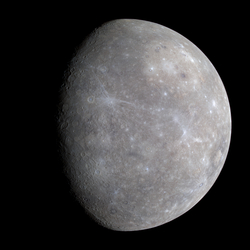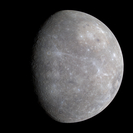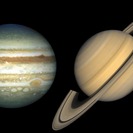Mercury - the nearest planet to our Sun - very closely resembles our moon. The surface is heavily cratered and due to a lack of erosion, all craters remain as they are. Mercury has a very big metallic core in relation to the size of the planet. In fact Mercury consists of just 30% silicate material and 70% metallic material. The reason for this is not known for sure, but the most widely accepted theory is that there was a giant impact involving Mercury during the early stage of the evolution of our Solar System. This collision stripped away a large part of the original crust of the planet.
Mercury is a planet of extremes for many reasons. With a radius of just 2440 km (the Moon's radius is 1737 km) it's the smallest of the eight planets in our Solar System. Mercury has the fastest orbital period of just 88 days - in one Earth year Mercury completes more than four orbits around the Sun. It also has the greatest temperature variations of all the planets: -173 °C during the night and 427 °C during the daytime: a whopping 600 °C temperature difference between day and night! It has the largest orbital eccentricity of all planets: at its greatest distance (aphelion) it's 1.5 times further away from the Sun than at its perihelion. Furthermore, Mercury rotates very slowly; an observer on Mercury would experience just one day every two Mercurian years.




